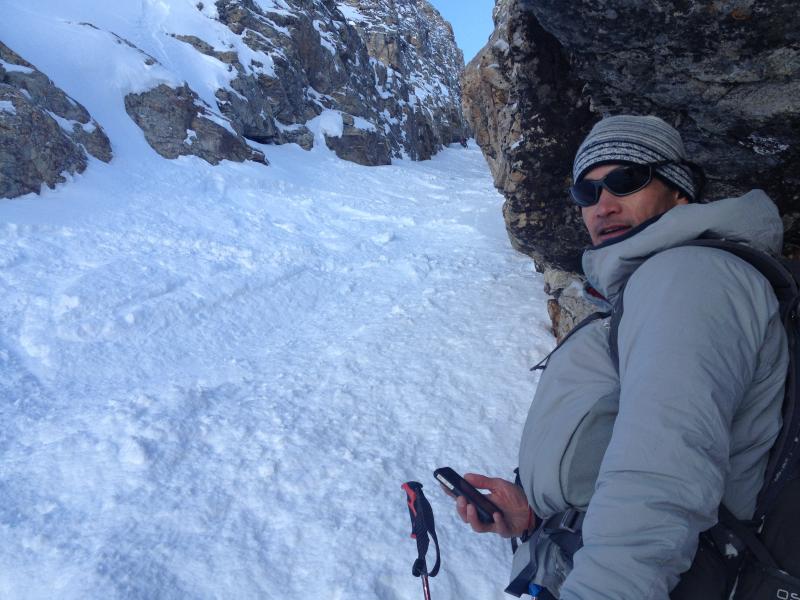
I went skiing in the Ruby Mountains of Nevada on my day off on Monday. When your good friend with prostate cancer from out of town calls on Saturday night and says, "We're going skiing in the Rubies on Monday and you're coming as well", you have no choice but to pack your stuff. Fittingly, he and mutual friend Terry picked a line called Terminal Cancer, a striking line plucked by Joe Royer back in the late 70s. Plenty of folks like to post the rad sick line they just hit...but the goal here is to convey the homework that goes into it - at home, and in the mountains. Ultimately, it's up to you to do the work and stack the odds in your favor. Or, you can just roll the dice - it is Nevada, after all - you might get lucky after all. The gist of this post is to describe how we went through and planned the ascent and descent and how we executed it. Cancer kills you slowly...avalanche death is quick and immediate.

Terrain: RED LIGHT
Terminal Cancer is the striking line that cleaves the north face of this ridgeline. The line is north-northwest facing, topping out at 9500'. The creek you cross to access it is at 7400'. Slope angles encountered are 30-40 degrees. Is this avalanche terrain? You bet. Our concerns were not just in the chute itself, but accessing the chute and what was adjacent to it. In other words, it is easy for the eye to be drawn to the line...and overlook the steep aprons and adjacent terrain beyond. We were just as concerned about the adjacent terrain as the chute itself.
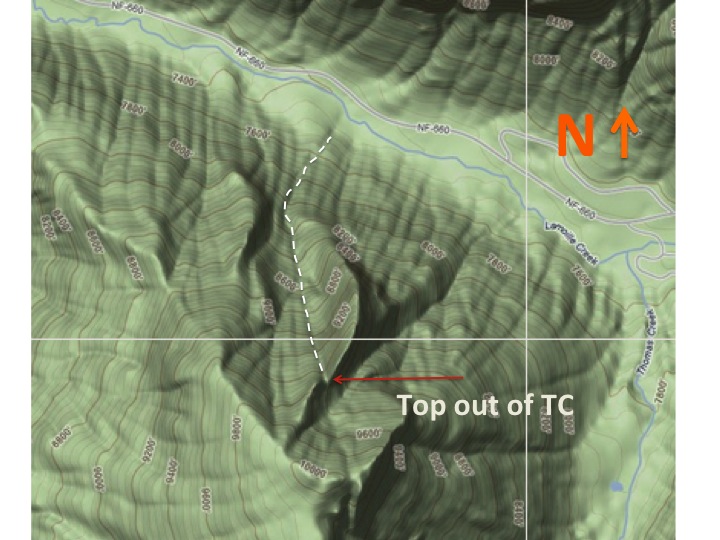
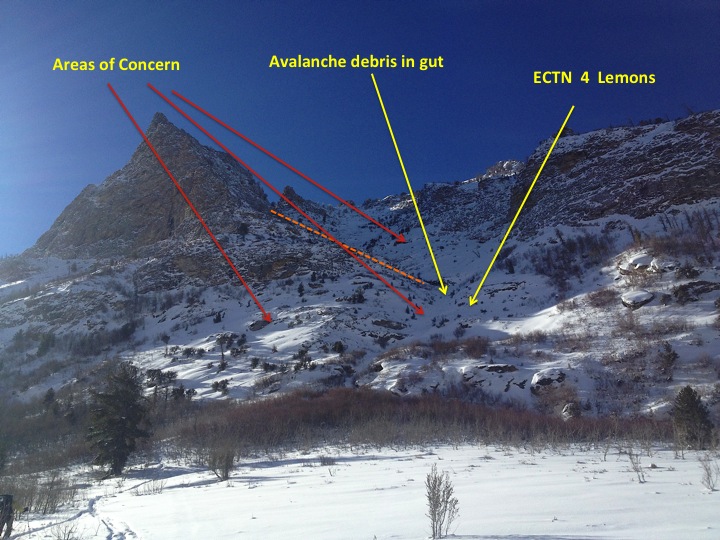
As it turns out, not much avalanche terrain sits above the line that necessarily dumps debris into it, as noted below. I say "not much".
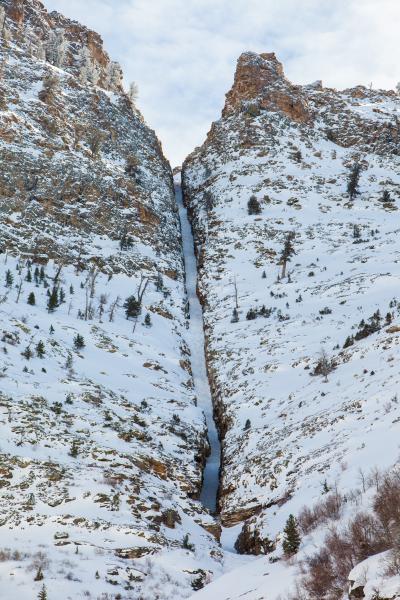
You have a little room to play with to access the couloir, but once you're in it, you're in the barrel of the gun. We noted avalanche debris in the apron and elected to travel up through the gulley of the apron. The idea being that that terrain had either already avalanched or the snowpackhad taken a direct thump from debris from above and would likely have avalanched then...not now. Still, we traveled up in two teams of two through the apron to give each other room. Once we gained the bottom opening of the couloir, we elected to continue traveling in two teams of two, skinning 90% of the way. This tells you two things: A-it never got over 40 degrees in the elevator shaft; and B-wallowingthrough the powder was waist deep...and likewise felt if we moved above any isolated areas of basal weaknesses we might stay above it on skis/skins.
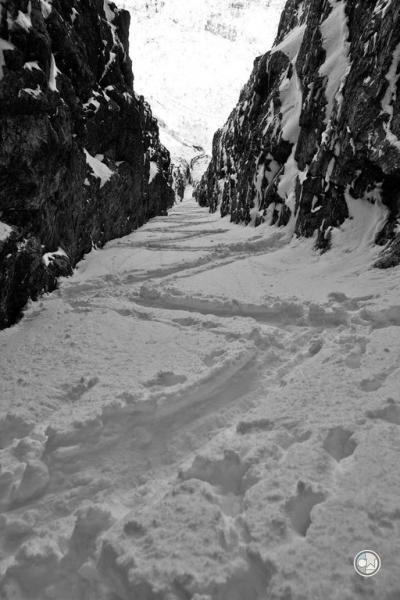
Periodically through the couloira group could tuck into little alcoves that offered some margin of safety.
And this was our plan for the descent - one at a time, tucking in to alcoves in order to maintain visual sight with one another. It goes without saying that we had beacons, shovels, probes.
Weather: GREEN
The storm that brought a foot of snow to the Wasatch over the weekend brought 14"/1.1" to the Rubies as indicated by the Lamoille snotel site. The storm commenced on Friday morning (February 8) and mostly wound down on the 9th. We were planning to ski it on Monday the 11th. Typically storm instabilities would settle out by then (storm snow, wind slab, loose snow), but the point here is that this was our opinion and we aimed to test it. Temps were in the 20sduring the storm, but dropped to the single digits through early Monday. Wind effect was not noted in the terrain. One worry was for direct sun to hit the new snow above and in the objective, but aspect and temperature kept the new snow in check.
Snowpack: GREEN
We noted no cracking or collapsing. The avalanche noted likely originated higher in the apron beneath the chute. We performed multiple probe tests to determine the structure of the snow below the chute and is outlined below. It had 4 of five lemons...the four being the top four below - Of note, the faceted layer was 4F hardness and did not seem overly weak and unconsolidated.
- Persistent weak layer (1mm facets) buried 15" down
- Depth of same within a meter
- Hand hardness difference clear beneath a 3mm melt freeze crust dividing the new snow and the old faceted snow
- Grain size difference was evident
- Weak layer thickness was 20cm....
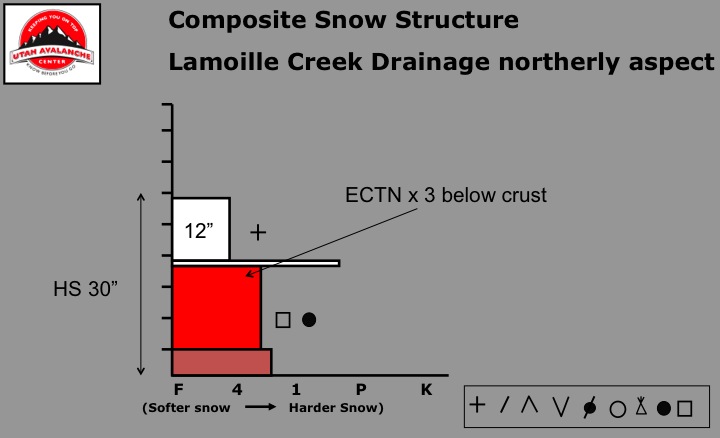
Continuous probe tests while in the barrel of the gun indicated very isolated areas of basal weaknesses...most of the structure had a very strong mid and basal structure due to wind loading and sluffing from above. Structure was good.

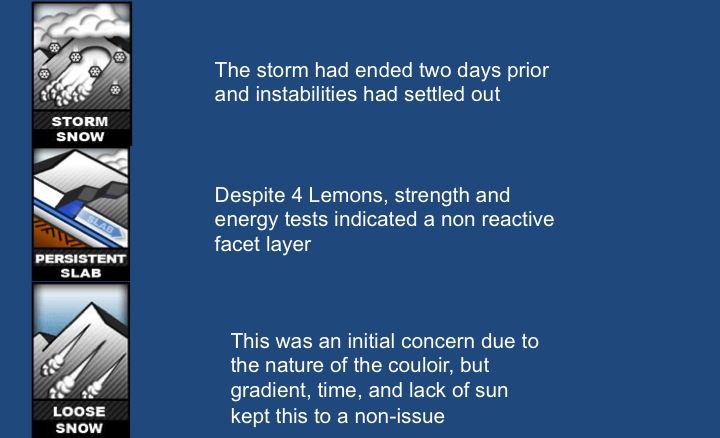
The Ski Party:

I hope not. We were a party of four. When heading into unfamiliar terrain and snowpack, it's key to choose your partners wisely. Our party consisted of three very good friends (>10 years) who have climbed and skiied together many many times.
Terry and I worked together on Rainier years ago and he currently works as an ER doctor. He's worked and climbed Everest many times. He's as low key and thoughtful as they come....cool under pressure and is a good communicator. Fit beyond belief.
"Bubba" is almost 50 and you'd never know he was sick. We joked that he brought along his personal physician in Terry. Bubba's worked as an avalanche forecaster throughout the intermountain west and is the poster boy for the ISSW - a merging of theory and practice. He's a great communicator, has good mountain sense, and has nothing to prove. "Summit fever" was not even part of the game.
Craig Wolfrom - This was a surprise for me. He is a professional photographer and I did not know he was part of the plan. This was a yellow flag for me b/c I consider outings like this to be among good friends without any peripheral agendas. Still, he proved fit and low key and was a welcome addition. Many of the photos are his.
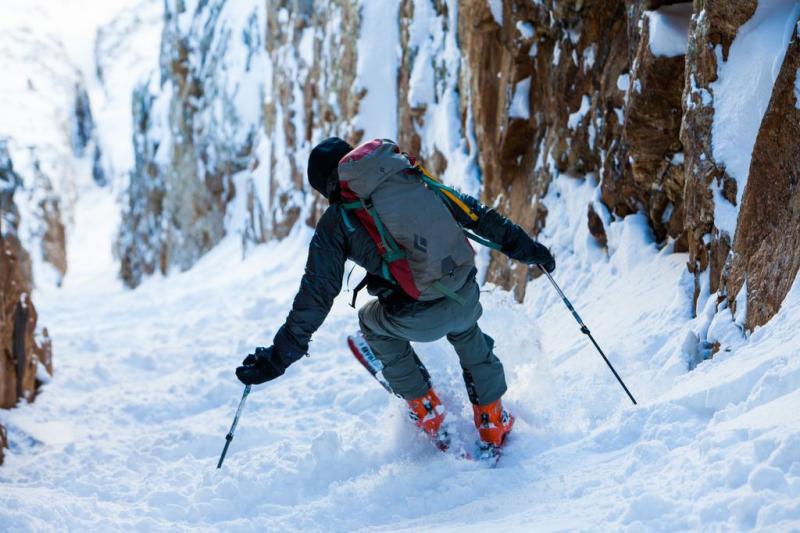
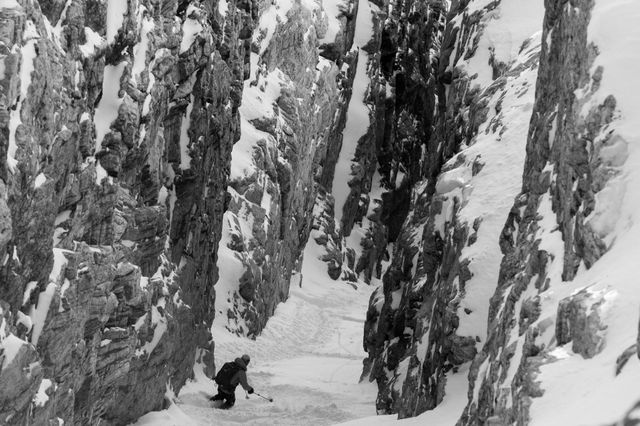
In summary, the only way we would approach this terrain is if we had green weather and a green snowpack. I felt very confident in our ski party and knew we'd done the work to make informed decisions. It's true that you can do everything right and still get the hook; still, our lives are made up of moments like these with friends like these. And I suspect that Bubba will be kicking for another 30 years...
Drew Hardesty
Forecaster, Utah Avalanche Center


